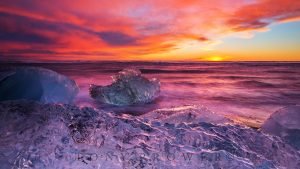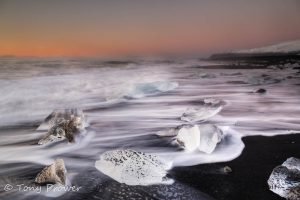When your local volcano erupts, grab your camera and tripod and head out for a Long Exposure Photography Adventure. There is nothing like being with other photographers who want to be there until it gets dark, so choose your company wisely.
All that fire spitting, smoke, and ash can give your photos a nice slow shutter feel. It is certainly worth driving across a glacier in a huge jeep in a wacky race of jeeps, snowmobiles, snow cats, skiers, and hikers. The Jeeps win with their huge tyres that are deflated to around 10lbs so they can float on the deep snow.
Long Exposure Magic
Electric Volcano
The image above was taken just 15 kilometres (10 miles) from the Icelandic volcano Eyjafjalljökull in 2010. The lightning bolts are too quick to rely on your reaction times, so I took a series of 20-second exposures, which would normally capture a lightning strike. This long exposure captured 2 or 3 strikes, which give the photo good dynamics and show the power of the volcano. Unfortunately, the photo has been heavily cropped, and would print large. My longest lens at the time was 50mm (on a full-frame sensor). I did rent a 200mm lens a couple of days later, but the lightning wasn’t as strong, and the friends I was with didn’t want to be out too late. I returned to Eyjafjallajokull one more time with the 200mm lens, but on this occasion the whole area was under the ash plume and we couldn’t even see the volcano.
Fimmvörðurháls Crater Eruption
This was taken on March 30th, 2010. The eruption occurred on a famous hiking trail between the Eyjafjalljökull and Myrdalsjökull glaciers.

The exposure time here is 1/2 second. This sort of shutter speed requires a tripod but could be achieved with careful use of a monopod. As the erupting lava travelled quite quickly, it created lines of fire during the exposure. Volcanoes are unpredictable, so my technique was to shoot several frames at regular intervals until my shutter matches a good-sized explosion. The long exposure affects the steam, and the result is mixed.
Dragon Smoke
Luckily, I was with photographers, and we were all keen for the light to fade. In the darkness, the volcano has more contrast. This was the closest I got to the crater, and I took many shots. I was pleased to see that in one of the photos, the steam appeared in the shape of a dragon.

| CAMERA | Canon EOS 5D Mark II |
| LENS | Canon EF 24-70mm f/2.8L II USM |
| ISO | 100 |
| FOCAL LENGTH | 24.0 mm (23.4 mm in 35mm) |
| APERTURE | f/11 |
| EXPOSURE TIME | 8s (8) |
Straight Eight
Eight seconds is the longest exposure time in this article. Such a long exposure to the erupting lava is not so beneficial because we start to lose detail in the core. However, the moving smoke took on a new life during the 8-second-long exposure. For this photo, I borrowed my friend’s Canon EF 24-70mm f/2.8L. I only used this lend for about 15 minutes, but I love the sharpness.
Eyjafjalljökull Ash Plume
… or not.
Interestingly, the first photo is a 2-second exposure, but it doesn’t look like a long exposure at all. The extra 3 seconds of exposure in the second photo have made a dramatic difference in the communication of movement. There are two factors that affect the exposure needed to communicate movement in a still photo. One factor is the distance from your subject. If you are close to the eruption, like I was at Fimmvörðurháls, the moving objects travel further across the frame. The ash in the distant Eyjafjallajökull eruption was moving tiny distances in the frame. Using a powerful telephoto is a remedy if you can’t get close to the volcano. The other factor is the type of object and the speed at which it moves. A volcano spits out tiny lava stones at quite a high speed; they can travel around 100 feet. Compare this to smoke, which travels much slower in comparison.

Photo Info
| CAMERA | Canon EOS 5D Mark II |
| LENS | Canon EF 70-200mm f/2.8L IS USM |
| ISO | 100 |
| FOCAL LENGTH | 78.0 mm (76.1 mm in 35mm) |
| APERTURE | f/8 |
| EXPOSURE TIME | 2s (2) |

Photo Info
| CAMERA | Canon EOS 5D Mark II |
| LENS | Canon EF 70-200mm f/2.8L IS USM |
| ISO | 100 |
| FOCAL LENGTH | 70.0 mm |
| APERTURE | f/8 |
| EXPOSURE TIME | 5s (5) |
Can you think of a natural situation where you might have 2 different objects moving at different speeds?


















